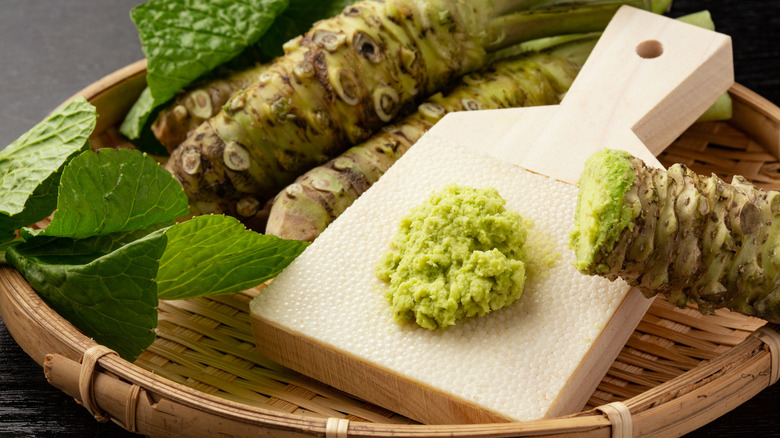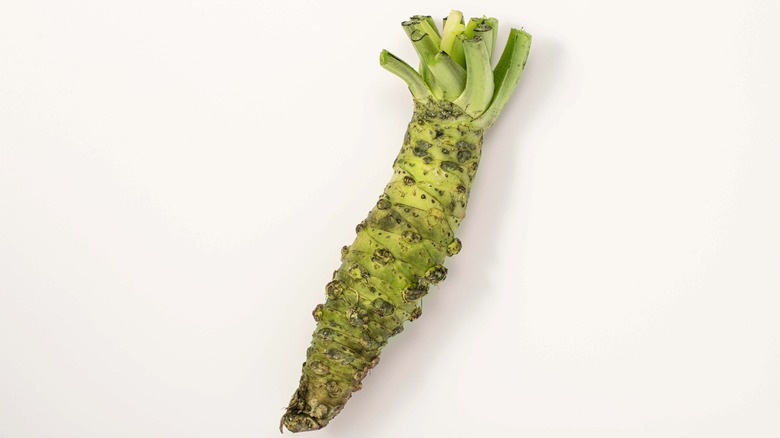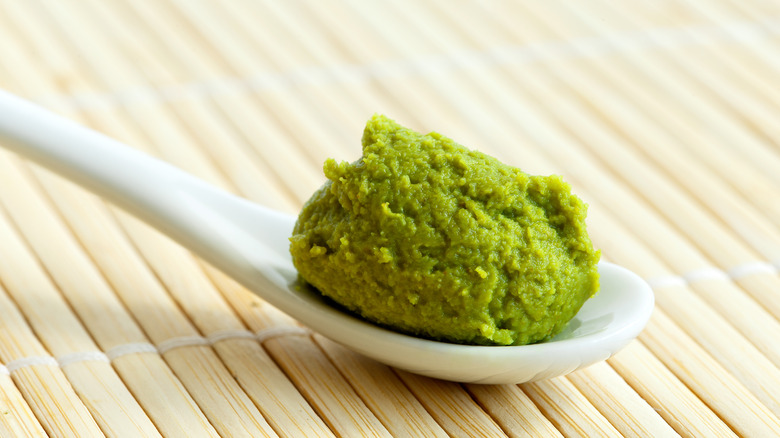Why Genuine Wasabi Is So Expensive In The US
Every order of sushi comes with a side of wasabi ... or so you've been told. According to The Washington Post, approximately 99% of wasabi sold in North America is fake. The same goes for around 95% of wasabi sold in Japan. Even when real wasabi is served, it's usually mixed with additives to bulk it up. The dupe has been widely successful, with few people ever questioning the authenticity of this ubiquitous condiment, but the differences between real wasabi and the mimicry you're probably used to are significant.
Genuine wasabi is made from the rhizome of the wasabi plant or the Wasabia japonica. A rhizome is a thick, rootlike stem that can also be seen in ginger and turmeric, and while the whole wasabi plant is technically edible, most culinary uses focus on the rhizome rather than the leafy top. Wasabi belongs to the family Cruciferae, also known as Brassicaceae and commonly referred to as the mustard family. This makes wasabi a relative of mustard, cabbage, broccoli, and cauliflower, among others.
Real wasabi is freshly grated just before serving. There is even a special tool for this purpose — a handheld grater called an oroshi. It is traditionally made from sharkskin, which has a texture like sandpaper. The fresh paste tastes delicate and slightly sweet, with a faint heat that dissipates quickly. The fake wasabi served by most establishments is much harsher in comparison. Why then, is it so much more prevalent? The answer lies in supply and demand.
Real wasabi is quite rare
The global demand for wasabi far outpaces its supply, but there's really no way for that supply to scale up because wasabi production is highly limited. The BBC describes wasabi as "the most difficult plant in the world to grow commercially" thanks to its intricate needs. To flourish, the wasabi plant must be grown in a cool environment ranging from 50 to 65 degrees Fahrenheit), must be kept away from direct sunlight, and must have its roots submerged in clear running water at all times. Even if the ideal conditions are met and maintained, the plant takes two years before you can harvest it.
In the natural world, it is only found along the river beds that wind through Japan's mountain valleys. Expanding its range has proved to be incredibly challenging for several reasons. Firstly, there's the matter of climate. Outside of Japan, wasabi has only been successfully grown in a small handful of places, mainly China, Taiwan, Australia, and New Zealand. Establishing new wasabi farms is difficult to do because the seeds of the plant are in such short supply. Farmers spend many years and thousands of dollars searching for viable seeds, an investment that can easily go to waste if the climate conditions aren't perfect, leading the crop to fail. Due to its scarcity, genuine wasabi can cost as much as $100 per pound.
If the wasabi you've been eating isn't real, what is it?
So, what have you really been eating with your sushi? The vast majority of commercial wasabi is made from European horseradish or Armoracia rusticana, which is distantly related to authentic Wasabia japonica. Horseradish is a familiar ingredient in Bloody Mary cocktails and French Dip sandwiches, instantly recognizable by a burning flavor that tickles your nose and throat long after swallowing. From a gardening standpoint, horseradish could not be more different than wasabi. It is one of the easiest plants to grow, suited to various climates, and it takes a fraction of the time to cultivate, needing just 140–160 days from planting to harvest. Plain old horseradish costs about three to five dollars per pound, approximately one-twentieth the price of real wasabi.
Producers of fake wasabi mix European horseradish mixed with mustard and citric acid. To match the color of authentic wasabi, manufacturers add green food coloring. Restaurants typically purchase it in powdered form, which they mix with water to form the dense paste we're all familiar with.
If you want to try real, genuine wasabi, you'll need to have some bucks to spare, and the determination to scout it out. Fresh wasabi rhizomes can be found in some Japanese markets, but for those in other countries, online retailers are the most reliable source. The real stuff loses its flavor after just 15 minutes, so be sure to grate it fresh as needed.


